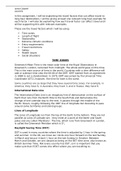James Caldwell
Unit 8 P3
In this assignment, I will be explaining the travel factors that can affect travel to
long-haul destinations. I will be giving at least one relevant long-haul example for
each factor. I will also be explaining how each travel factor can affect travel and I
will be supporting this with relevant examples.
These are the travel factors which I will be using:
Time zones
Length of flight
Seasonality
Extreme climatic conditions
Entry requirements
Travel restrictions
Safety
Health issues
Social situations
TIME ZONES
Greenwich Mean Time is the mean solar time at the Royal Observatory in
Greenwich, London, reckoned from midnight. The whole world goes on this time.
This is the main source of time in the world. Countries with a time difference will
add or subtract time onto the 00:00 of the GMT. GMT started from an agreement
in 1884 to set a standardised. In 1979, GMT was joined by the Universal Time
Coordinate (UTC), however, the time for both is the same.
Some countries are so large that they have several time zones. For example, in
America, they have 6, in Australia, they have 3, and in Russia, they have 9.
International Date Line
The International Date Line is an imaginary line of demarcation on the surface of
Earth that runs from the North Pole to the South Pole and demarcates the
change of one calendar day to the next. It passes through the middle of the
Pacific Ocean, roughly following the 180° line of longitude but deviating to pass
around some territories and island groups.
Lines of Longitude
The Lines of Longitude run from the top of the Earth to the bottom. They are not
parallel as Lines of Latitude are – they meet at a point at the North and South
poles and are called ‘Meridians’. The line, which runs from Greenwich in London,
is called the Greenwich Meridian which is 0°.
Daylight Saving Time (DST)
DST is used in many countries where the time is adjusted by 1 hour in the spring
and summer. In the UK, we move our clocks one hour forward on the last Sunday
in March and we put it back 1 hour on the last Sunday in October. Between
March and October, we are classed as being on the BST time zone, also known as
British Summer Time. Not every country has DST, so it is important that you
make sure that if DST comes into effect where you are travelling to.





